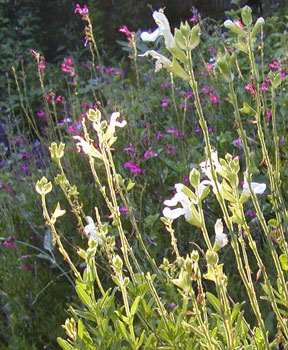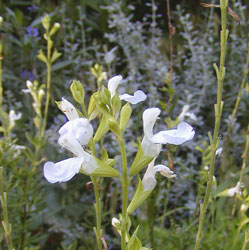Autumn Sage, Cherry Sage
Salvia greggii

. . . for spring through autumn bloom
Common Name: Autumn Sage, Cherry Sage
Botanical Name: Salvia greggii
Design Tip: Place in front of borders or hedgerows for months of color. Front with an evergreen edging and surround with a colorful low-lying annual ground cover or surrounded by other sun loving plants in a mixed border. A bushy appearance and high heat tolerance makes it a popular xeriscape material in naturalized plantings.
Form: This undemanding sub-shrub provides a durable border perennial. Most varieties maintain an upright form while some of the newer cultivars produce lax stems sprawling near the ground.
Size: Without grooming, a mature plant maintains a 2-3 foot mound.
Flowers: Two to three one-inch, blooms occur on the tip of each stem. The common name of autumn sage refers to its best bloom phase in late summer and fall in summer-drought regions and in northerly zones. In irrigated bedding, flowering begins in spring in warm climates. Cultivars offer a wide range of colors including pink, red, burgundy, peach, corral, white, purple and bi-colors.
Foliage: Half-inch oval green leaves have an aromatic sage-like scent when bruised. It remains evergreen in frost-free zones.
Soil: Although indigenous to dry alkaline land, best ornamental performance occurs in a well-drained, irrigated soil in full sun. It will not survive in heavy clay, unless planted on a slope for high drainage.
Cold Tolerance: It is hardy in USDA Zones 7 to 10.
Grooming: A twice annual pruning regenerates healthy new growth and maintains a tidy mounded shape. Cut back by half in February and August. Without grooming, old woody branches become spindly and brittle, resulting in die back.
Propagation: Cuttings can be rooted from stem tips, but self-sown seedling occasionally occur around the parent plant in warm climes.
Snippets: Native to Southwest Texas and Mexico, it provides a food source for butterflies and hummingbirds, and is reportedly deer resistant.

Cultivated, photographed and written by
Maggie Ross McNeely in Fort Worth, Texas
All rights reserved